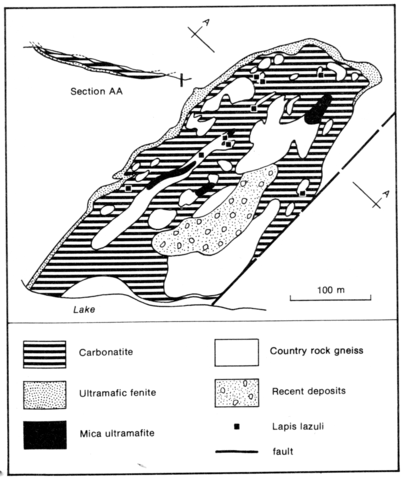stripes
Lying only 11 km north-northwest of the Qaqarssuk complex (No. 26), the Tupertalik carbonatite intrusion only measures 500x200 m and is emplaced as a conformable sheet in leucocratic gneisses with bands of amphibolite. As exposed the intrusion is some 10 m thick, contains a number of roof remnants and sends carbonatite veins into the surrounding gneiss. The carbonatite is a flow-banded, generally coarse rock of either calcite or calcite plus dolomite. Pegmatitic dolomite layers occur in places. Other minerals present include olivine, diopside, phlogopite and magnetite with lesser amounts of apatite, green spinel, amphibole and accessory zircon and unidentified minerals. Flow-banding is parallel to and more accentuated near outer contacts, and layers and schlieren of contrasting mineralogy are usual. Carbonatite veins up to 20 cm thick extend for 25 m into the country rocks. Along the outer contacts of the intrusion there is a 1-10 m wide zone of coarse ultramafic rock consisting of green amphibole and clinopyroxene and lesser phlogopite. Larsen and Pederson (1982, p. 42) believe this rock to be a reaction product of carbonatite with gneiss but with the involvement of an original ultramafic layer of the gneiss. Masses of sky-blue lazurite occur in contact zones under roof remnants and in xenoliths.
LARSEN, L.M. and PEDERSEN, A.K. 1982. A minor carbonatite occurrence in southern West Greenland: the Tupertalik intrusion. Gronlands Geologiske Undersogelse, Rapport, 110: 38-43.
LARSEN, L.M., REX, D.C. and SECHER, K. 1983. The age of carbonatites, kimberlites and lamprophyres from southern West Greenland: recurrent alkaline magmatism during 2500 million years. Lithos, 16: 215-21.
L. M. Larsen, personal communication, 1983.

